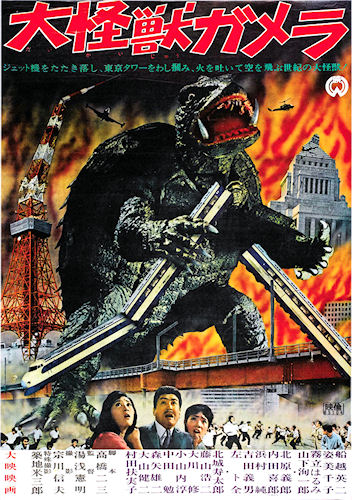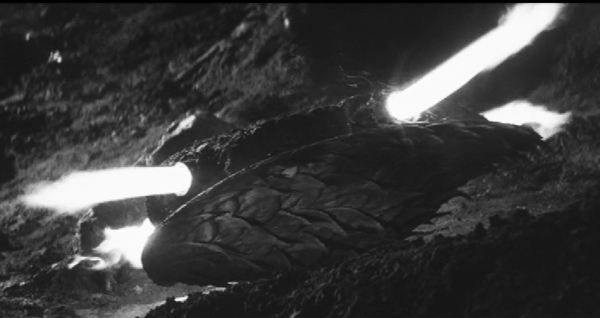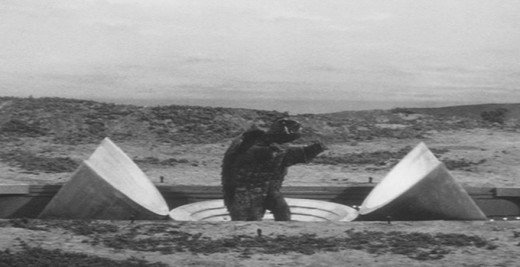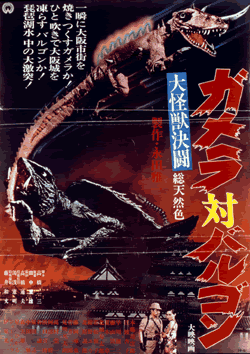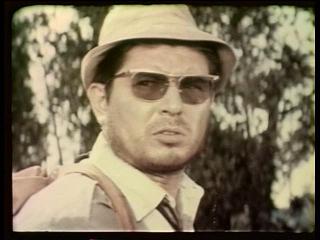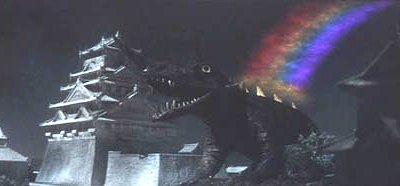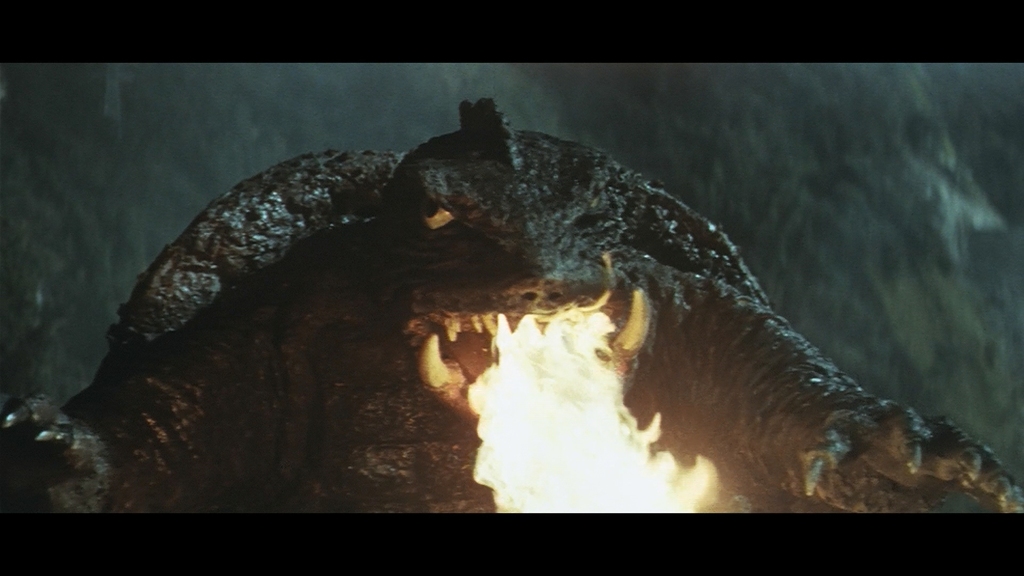Welcome to Angry Turtle!, a new series featuring Deadshirt.net’s own Patrick Stinson and guest writer Andrew Tucker. We are going to be reviewing the Gamera series, the rival of the famous Godzilla series. The name comes from this charming video.

Patrick: Hello, all, and welcome to our look at the Gamera series. If you are a Japanese monster movie/kaiju nerd, you have likely heard of him. If not, well, he’s a giant fire-breathing rocket-propelled turtle.
Andrew: Ah, but he is also the guardian of children. That is, when he’s not savagely slaughtering civilians in his blind animalistic rage. Gamera, like Godzilla, changes in motivation throughout his series. They both fluctuate between violent forces of nature and pure tokusatsu, AKA what you think of when you think of Japanese giant monster movies, fun. There are darker entries in both series, but at their core, both Gamera and Godzilla reflect a very Japanese theme of post-WWII atomic fear and a conflict of cultural tradition.
Patrick: Gamera obviously doesn’t have the media penetration of his inspiration and counterpart, Godzilla. However, if you look, you’ll find him sneaking into various mainstays of US pop culture. He’s appeared in the Dragon Ball manga, Justice League Unlimited, and most famously was the subject of a run of Mystery Science Theater 3000 episodes.
The series itself is known for a couple of things that distinguish it from its rival. First and foremost, the Gamera series is aimed at children. As such, Gamera develops into possibly the very first unambiguously good kaiju. This had a major effect on the Godzilla series. Second, and related, the Gamera movies tend toward the surreal. They are campy yet gory, with enemy monsters that are sort of nightmare grab bags.
Andrew: It’s hard not to think of Godzilla when you watch these movies. Outside of the obvious “rubber-suited giant monster” shtick, the Gamera movies share common themes and even story structure with their contemporary Godzilla films.
Patrick: We are beginning at the beginning with Gamera the Giant Monster. Released in 1965, this is one of, if not the first, kaiju movies that was not filmed by Toho Studios. Director Noriyaki Yuasa had the idea to develop a giant turtle movie in order to use some miniature sets that his studio, Daiei, had just repurposed from an abandoned project. The result is a movie that does feel very much like a trial run, a proof-of-concept that kaiju movies to compete with Toho can in fact be made.
Andrew: Not to get too far ahead of ourselves, but that makes a lot of sense. I actually did not know what the inspiration for Gamera was until now. It is a mess of a movie. That helps explain the definite disconnect between the humans and the monsters in the first two movies.
Patrick: Yeah, if I were to suggest the quintessential kaiju movie, one that doesn’t feature fighting and yet has more of the stereotypical cheesiness than the very real pathos of Godzilla, it would be Gamera the Giant Monster. It ticks all the boxes. Atomic bomb connection. Destroys Tokyo. Scientists bustle around and try plan after plan. Name of monster starts with “G” and ends with “A.” (Godzilla, Gamera, Gappa, Guilala.) The name is even depicted in katakana characters because the Toho kaiju names were written this way.
Andrew: Don’t forget little kid with baseball cap and couple helping scientific old man.
Patrick: Yeah. And it’s in black and white, like the nine-years-previous Godzilla. Mind you, I don’t think you can call this a deliberate invocation of all these cliches. Several of these elements, like the friendship of young boy and monster and the destruction of Tokyo Tower, had not been attempted previously, so the movie establishes as many traits as it apes. Perhaps the movie is best understood as a cash-in remake of Godzilla, in the style of Toho’s own Varan, but with enough unique elements to inspire the madhouse series that followed it up.
Andrew: Gamera definitely has unique elements. Having watched the 1990s “Heisei” Gamera films, I can see the seeds of some of the great ideas there; however, Gamera the Giant Monster is a clunky combination of old ideas that overshadow some interesting new ones.
Patrick: So how about the start of the film here? Definitely an action-filled opening, more akin to blockbusters today than the deliberate beginnings of most contemporary kaiju epics. We meet our main characters at an Arctic village, then they witness a straight-up US vs. USSR dogfight. It ends with a bomber crashing and nuking Gamera awake.
Andrew: I really like the opening. We’ve got different cultures interacting between the Japanese and the Inuit while overhead, mysterious world powers carry out their selfish conflict. The US and USSR are faceless entities in this movie despite a few characters from either side showing up. Godzilla opens with a catastrophe ripped from current events with the destruction of the Lucky Dragon No. 5 at the hands of a nuclear power (in the film, of course, this is Godzilla), but here we are introduced to a Cold War kaiju.
Patrick: Despite this powerful subtext at the start, the film takes a couple of detours after Gamera first is shown at large. We continue to follow the scientists that we met in the Arctic village, but we also have a mysterious series of UFO sightings. Then we meet Toshio, the son of a lighthouse keeper.
Andrew: And this is where the movie started to go off the tracks for me. I found Gamera’s first appearance to be exciting and terrifying, especially since I knew him as a guardian monster. With Toshio’s arrival, and the obvious tension between him and the adults, I was expecting Gamera to be the personification of Toshio’s anger and confusion. Instead, Toshio is relegated to a rather uninvolved character in a movie that seemed to billboard the meeting of these two characters. Toshio spends the rest of the movie complaining about the way the military treats Gamera, but Gamera isn’t given any redeeming qualities. Even in King Kong, the audience feels for Kong, who attempts to flee violence.

Patrick: Agreed, the movie is ambivalent on Gamera to the point of incoherence. One of the first things Gamera does is save Toshio’s life. Toshio thinks deliberately, the adults think by happenstance, but the question isn’t explored any further. Now, given that most of Gamera’s rampage centers on his search for energy, it definitely would have been possible to do a movie about a “good” monster only causing damage by accident. However, in a late sequence Gamera–for no other reason than “Godzilla did it”–levels and burns a great deal of Tokyo! This is a visual effects tour de force that I would hate to lose, but it’s jarring both in this film and, as we will find, in the Gamera series.
Andrew: I found a lot of Gamera’s rampage sequences to be disturbing by the movie’s own setup. Toshio repeatedly tells the adults around him that Gamera is just confused, Gamera is hungry. And yet, Gamera flies by an airport tower full of people multiple times before crashing into it, then rips the ceiling off of a club and sets the inhabitants on fire and continues his destruction. It works in Godzilla because Godzilla is not supposed to be liked. We understand that he has been scarred by a nuclear bomb, we understand that he is confused, we understand that the destruction he causes is not solely out of malevolence, and we even pity him a little as he gruesomely dies; but when the soul of the movie, Toshio, keeps arguing for more understanding, it makes these scenes jarring. Especially since Toshio never really sees Gamera as a negative force, even by the end of the movie.
Patrick: What I think struck a chord with audiences was the unique characteristics of the monster itself, all of which are established in this debut film. Gamera looks like a turtle, can walk like a man, breathes fire, and can absorb any inorganic source of energy, making him very difficult to starve or kill. Moreover, as the characters discover in the second act, Gamera and the UFO are one and the same. Gamera foils a scheme to flip him over by retracting his limbs and head, blasting fire out of a quartet of nozzles, and blazing off into the sky, whirling like a top!
Andrew: First of all, I love the plot to flip him over. On the one hand, it’s completely ridiculous given the horrifying circumstances that they have just faced; on the other, it makes complete sense. Flip the turtle on its back and watch it die. But as far as Gamera as a character is concerned, he’s an instant Showa classic. The “Showa” era of kaiju movies, referring to the original postwar films produced under the reign of Emperor Hirohito, is known for both grounded monsters (the giant pterodactyl Rodan) and the more unique (Gigan, an insect-like monster with blades for hands and buzzsaw on his chest). Gamera is somewhere in the middle. He can spit fire, which is borrowed from Godzilla, but his ability to fly is what really sets him apart. Later, they’ll introduce other abilities that make Gamera even better (I’m lookin’ at you, chest beam), but that first flight scene is unforgettable. I feel like it’s a little lost in this debut film as this ability is a lot more fun than the rest of the movie (rocket plot aside), but it still introduces Gamera as a new classic in the kaiju canon.
Patrick: Just to briefly touch on that and wrap up, this movie is at its least boring when the military is trying to deal with the unique set of characteristics that Gamera possesses. He’s an indestructible turtle so, freeze him, plant some bombs, and flip his ass. That doesn’t work? Well, he eats fire, so lure him away from people with a shitload of that. Around the end of the second act all of the characters get really excited about the “Z Plan,” which they conspicuously avoid explaining to us. It even wins over the Gamera-loving Toshio at some point off screen. The script is very clumsy here, but holding off the reveal is worth it, because the Z Plan is to lure him into the nosecone of a giant rocket and blast him the fuck to Mars! It just closes on him like a giant bear trap. The ultimate problem of Gamera is that the movie is not ALWAYS this crazy. When it’s crazy it’s running on all cylinders.
Andrew: It does seem to exhibit some growing pains in the kaiju tokusatsu genre. The first half plays much like the original Godzilla, with the destruction and A-bomb motifs, but the second half is much like Mothra vs. Godzilla, in which the horror of the original character has subsided and we get to enjoy some relatively light-hearted giant monster versus military scenes. The ending, though, is straight out of “build a black hole and push that fucker into it” territory. And yes, for those who don’t know, this is a method that was used to defeat Godzilla in 2000’s Godzilla vs. Megaguirus.
Patrick: Gamera is an instantly classic character in a fairly poor movie. The second film in the series, Gamera vs. Barugon, puts Gamera in a pretty decent movie that very much does not appreciate him. Despite getting top billing, Gamera is little more than a plot device here! The main story centers around an expedition by Japanese war veterans to retrieve a massive opal one of them secreted in New Guinea. Ignoring warnings from the local tribe and the Japanese scientist who lives there, they uncover the stone, only to confront twin dangers–expedition member Onodera who is busily knocking off everyone else with a claim to the item, and the fact that it’s actually the egg of the kaiju Barugon.
Andrew: I really liked the plot of this movie and how it evolved the “evil businessmen screw with Nature” theme, but I honestly found myself forgetting I was watching a Gamera movie. And the Godzilla movies have done the same thing, many times saving Godzilla’s entrance for the last fight of a movie, but this is the second Gamera movie. He has yet to be established as a hero.
Patrick: Gamera vs. Barugon is just as strange an entry in the larger Gamera canon as the first movie. While the formula of “Gamera fights another monster, gets his ass kicked, and comes back in the third act to win” is established here, the other elements of the movie are unique. It’s centered around a very bleak adventure story. No children appear at all. The color palette is almost as monochromatic as the previous film…which was in black-and-white. And Gamera is not allowed to exhibit any character, meaning that he is a hero only in a structural sense. These anomalies are explained by the fact that in this installment, director Yuasa was actually demoted to visual effects director. He’ll be back in the big chair for the remainder of the first Gamera series.
Andrew: I found the plot and relationship involving Keisuke and Onodera to be very compelling. I wish Barugon was a more interesting monster because this could have been a vehicle for him alone. Onodera is a very malicious character who represents that capitalist villain trope that shows up in many of the kaiju films.
Patrick: Among the admittedly rarefied crowd that has seen this movie, the general consensus is that Onodera is the most evil cinematic character in history. He is a murderer by deliberate neglect, then a murderer by action, and finally beats a handicapped veteran and his wife and traps them in the path of a monster. He’s not particularly bright, or clever, or motivated, and yet he causes the rampage of Barugon, suggesting that greed alone is sufficient to cause worldwide devastation. He’s just appallingly venal.
Andrew: He reminds me of the character Kumayama from Mothra vs. Godzilla, whose greed pushes him to steal two fairies from Mothra’s island and is ultimately killed by Godzilla’s rampage toward Mothra’s egg. Something that has always struck me as brilliant in that film is how Kumayama’s lust for wealth is mirrored by Godzilla’s lust for the egg, a lust that ultimately kills Kumayama. He’s also so blinded by money, he’s blind to Godzilla’s arrival. Onodera, on the other hand, is malicious. I found the scene in which he traps Kobe under furniture and knocks his wife unconscious to be deeply disturbing. This, after we watch him allow his own companion to be killed by scorpion. It’s not something that is necessarily significant to the monster plot, but not much is significant in the monster plot to begin with, which is what I found to be most disappointing about this movie.
Patrick: This is a kid’s movie like Transformers the Movie is a kid’s movie. Check out the graphic deaths of your heroes, kids!
Andrew: It’s okay, though, ‘cause rainbows.
Patrick: Right?! If you thought Gamera was weird, you will not be able to handle Barugon. He looks like a lizard with a horn, which is standard enough. But he leaks liquid nitrogen everywhere, he’s got a pop-out tongue that shoots more liquid nitrogen, he bleeds on contact with water, he grows faster than Ridley Scott’s alien, and oh yeah…
Andrew: Rainbows! Barugon’s special power is literally killer rainbows. He fires a rainbow arc out his back that causes massive amounts of devastation.
Patrick: Barugon is not really a cohesive monster? Like, between freeze breath and the rainbow death ray he has a weak weather theme, and there’s always the “fire and ice” thing, but mostly his weird combination of abilities and weaknesses only exists to justify the lengthy second half of the plot with the military trying all manner of things to kill Barugon. He should have been just a straight-up cold-themed monster.
Andrew: His ability to freeze things does make him the perfect adversary for Gamera, whom he incapacitates by freezing him. The humans then conveniently forget about Gamera until the end of the movie, because I guess they feel they can only deal with one giant monster at a time?
Patrick: Gamera doesn’t interact with the human cast AT ALL. It’s very striking. His scenes and some of Barugon’s are connected to the rest of the film only by that ultimate cinematic sin, narration.
Andrew: The narration in this movie stands out like a sore thumb. I’m not even sure why it was necessary. I felt like the scenes were pretty self-explanatory.
Patrick: Historically, Gamera vs. Barugon has been the favorite original Gamera movie of people who don’t really like the original Gamera series. No kids to be found, cheese is minimal, and Gamera is still more or less a rampaging beast.
Andrew: Which is exactly what I feel is missing from this installment. There was groundwork that the first Gamera laid despite its flaws, but this movie throws all of those out of the window despite being a compelling human drama.
Patrick: We will see the classic Gamera formula begin to assert itself in the next installment of Angry Turtle!
Acknowledgement to the work of August Ragone, particularly this series of videos about the Gamera films.


